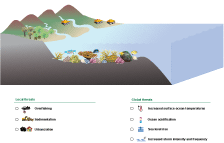What is climate change? |
Climate change results in a warmer Earth
The Earth is getting warmer and higher temperatures mean big changes for all ecosystems, and particularly coral reefs. The surface of the Earth has warmed about 1° F since the mid 1970s and the eight warmest years on record have all occurred since 2001. By the end of this century, the best estimate of temperature increase is 5.4° F (IPCC 2007). This trend makes the land and ocean warmer and alters long-term weather patterns. These effects are known as climate change.
Though climate change is happening, it is not always easy to observe. At any time, we can go outside and observe the weather, but climate cannot be observed in one day or even one year because climate is the long-term weather conditions in a region. However, long-term monitoring programs, such as the one conducted by the National Park Service Pacific Island Inventory and Monitoring Network help us observe the impacts of climate change in the Mid-Pacific.
Be a Web Ranger and investigate the global connections of climate change.
Greenhouse gases are the driving force behind climate change
Greenhouse gases, such as carbon dioxide, methane, and nitrous oxide in the atmosphere allow some of the heat from the sun to be absorbed by the land and ocean. The rest of the heat is reflected into space, keeping the earth within a stable temperature range comfortable for plants and animals. However, too much greenhouse gas in the atmosphere causes problems for living things. Since the Industrial Revolution, human activities have increased greenhouse gases in the atmosphere (IPCC 2007). Greenhouse gases now occur at levels so high that they actually change our climate. High levels of greenhouse gases cause climate change by trapping heat reflected from the land and ocean and preventing it from leaving the Earth’s atmosphere. The trapped heat makes air and water temperatures warmer. This process is called the greenhouse effect and leads to global climate change.






